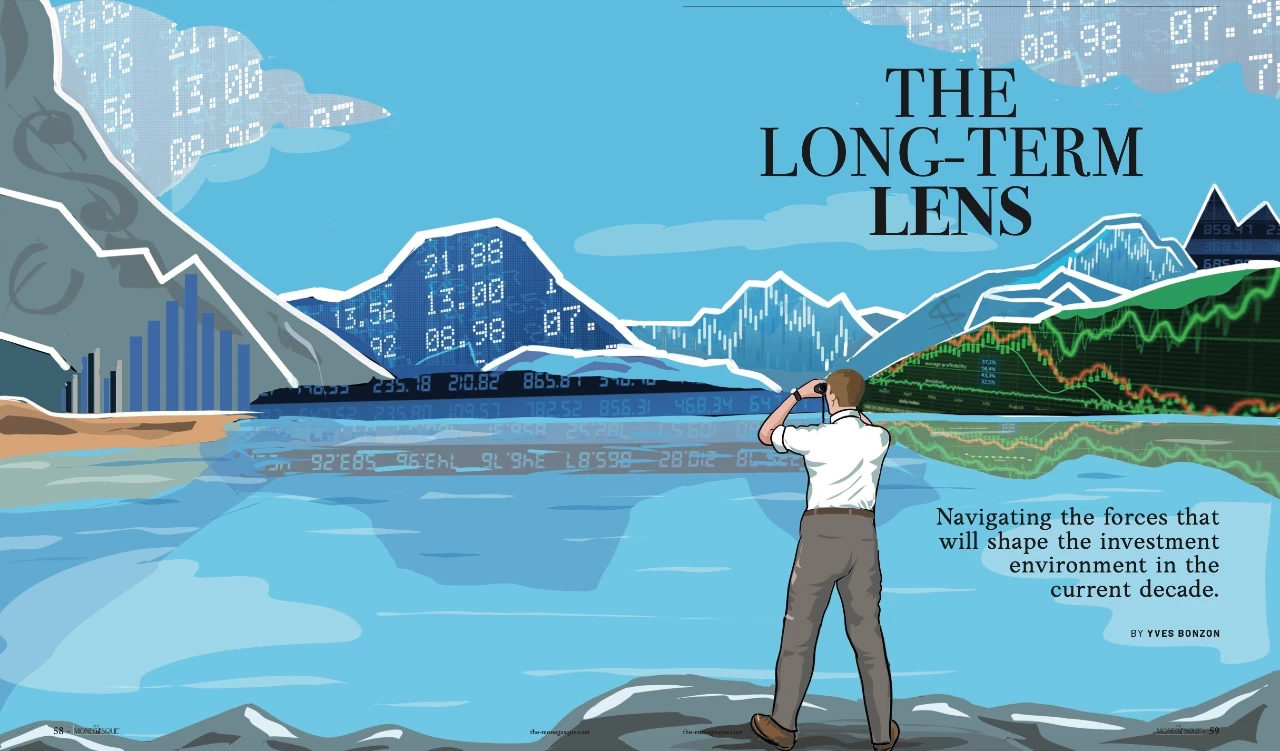The Long-Term Lens
Navigating The Forces That Will Shape The Investment Environment In The Current Decade.


HOW YOU INVEST IT
EVERY DECADE carries its own signature distinctive forces that influence how economies evolve, how societies adapt and, ultimately, how value is created. Yet, with constant headlines and daily market noise, these forces often get forgotten. We believe it is essential to pause, reflect and reassess at regular intervals the deeper, structural trends that will define not just this year or next, but the course of the decade. This is the purpose of the Julius Baer Secular Outlook.
December and January are the months when annual presentations outlining the investment outlook for the year ahead usually appear. All asset management companies focus on predicting what will happen over the next 12 months, including which asset classes and even which stocks will benefit. This is certainly an intellectually interesting exercise. The problem is that it is of little use if you want to invest successfully over the medium and long term. Firstly, there is no particular magic associated with dividing up time into calendar years. Of course, everyone measures performance in calendar years, but you do not sell your portfolio on December 30 and reinvest it on January 2. Time does not stand still on New Year’s Eve. The aim is to achieve a composition of returns over several years and the key to achieving it is not to lose sight of this objective, along with the discipline in the investment approach that it implies.
The Secular Outlook is not a forecast. It is a framework; a long-term perspective designed to identify and analyze the trends that will define this decade and beyond. It is a lens that sharpens our understanding of the structural forces at play, enabling us to make informed investment decisions that go beyond short-term reactions. As history has shown, structural shifts in the global economy (whether technological revolutions, geopolitical realignments or demographic transitions) have always been the true drivers of value creation. Our role as investors is to understand these forces and position our portfolios accordingly.
The 2020s are shaping up to be a decade of transformation. From the fragmentation of global power structures to the acceleration of technological innovation, the themes emerging today will have far-reaching implications. These themes are interconnected, influencing not only economies and markets but also the way we live and work. By examining these trends in depth, we can begin to understand the larger story they tell and the opportunities they present.
Multipolarity and Strategic Restoring
Since the start of the current decade, the global geopolitical environment has become more fragmented and uncertain and economic ties are increasingly influenced by geopolitical considerations and the need for resilience. The rise of a multipolar world order has led nations to reassess the critical interdependencies in their supply chains, resulting in so-called “strategic reshoring.” While globalization is far from over, its dynamics have evolved. This is not full-fledged deglobalization, but rather the reconfiguration of global trade in strategically important industries, such as technology or energy.
For example, after the beginning of the geopolitical conflict in Eastern Europe, Europe’s energy dependence on Russia triggered an immediate and costly effort to diversify energy sources. Meanwhile, the widening rift between the West and China, as well as the parallel breakthroughs in artificial intelligence, have triggered a global race to build up domestic semiconductor industries, whose supply chain today is highly globalized.
For investors, the implications are profound. Multipolarity introduces new risks, especially as economic fragmentation increases volatility. In particular, we see an increase in inflation volatility, as the likelihood of supply-side shocks rises, ultimately increasing average inflation in the 2020s to 3%, higher than the 2% average of recent decades. At the same time, the new geopolitical paradigm introduced the weaponization of the global financial system, marking an increased risk of capital confiscation when investing globally and a shift of non-Western central banks to diversify their US dollar exposures, notably towards gold.
Nonetheless, opportunities will emerge in markets and industries that adapt to the shifting dynamics of global power. By understanding how alliances and regional markets evolve, we can position portfolios to take advantage from these changes.
Active Industrial and Fiscal Policies
In response to the challenges of the 2020s (climate change, technological leadership and growing wealth and income inequalities) supercharged by two major external shocks (Covid-19 pandemic, geopolitical conflict in Eastern Europe), governments have ventured into a new era of active industrial and fiscal policies. This marks a structural shift away from the neoliberal policies of the past four decades.
Governments are actively directing financial resources into strategic sectors such as semiconductors, green energy and infrastructure. For instance, the Inflation Reduction Act in the United States and the European Chips Act are examples of targeted fiscal policies designed to bolster resilience and foster innovation.
State-directed investment is now seen as necessary to address the structural challenges that lie ahead. For investors, this trend underscores the importance of aligning portfolios with government priorities and identifying players that stand to benefit from pro-cyclical fiscal spending.
That said, we currently see the innings of a global bifurcation in the appetite for fiscal profligacy. While the median voter in Europe wants an increase in the size and scope of government intervention, the median voter in the US has just voted for the opposite.
The Innovation Super Cycle
The current wave of innovation, driven by artificial intelligence, renewable energy and advancements in healthcare, is transforming industries at an unprecedented scale.
Generative AI is a key driver of this transformation. Its applications range from logistics and education to pharmaceuticals and entertainment, creating new possibilities for efficiency and growth. Meanwhile, the energy transition continues to accelerate, driven by advancements in renewable technology and increasing investment in clean energy.
While the innovation super cycle offers enormous potential, it also requires discernment. Not every breakthrough will translate into commercial success and investors must differentiate between hype and substance. In AI, meaningful write-downs as the space matures are to be expected, much like in previous cycles of technological innovation that were coupled with massive capital expenditures. In this sense, AI is big indeed, but it would be dangerous to consider it an investment no-brainer. While we expect a broadening of the sectors that will benefit from advances in AI, we need further evidence to assess the actual impact it will have on different industries and the economy as a whole.
China’s Balance Sheet Recession
China faces a unique and critical juncture. The country is grappling with a shrinking population and the collapse in its real estate sector, leading Chinese households and businesses to deleverage and focus on accumulating savings rather than spending or maximizing profits—a situation called a “balance sheet recession.” These challenges have placed downward pressure on economic growth.
The Chinese government has announced fiscal measures, the only possible remedy to a balance sheet recession, yet the pledged stimulus, while a step in the right direction, has failed to impress so far. One-off fiscal transfers to the private sector do not ignite a self-feeding credit and consumption cycle. Therefore, high savings and weak domestic demand may persist, likely keeping the country in a balance sheet recession for much of the decade. Even if the Chinese authorities were to act quickly and efficiently enough to address the balance sheet recession, structural issues, such as the ageing population, remain a major concern.
A Framework For The Future
The Secular Outlook is a guide to understanding the gravitational forces at play and what they mean for where economies and markets are headed over the longer-term. By identifying and analyzing the resulting structural trends, it provides a framework for navigating complexity with clarity and purpose.
At Julius Baer, our goal is to translate these insights into actionable investment strategies to ensure that our clients are well positioned to achieve their investment goals within an acceptable range of volatility in a rapidly changing world.
As Philippe Honegger, Head of Investment Advisory at Bank Julius Baer Monaco, points out: “During the portfolio construction phase, in close collaboration with our clients, we place great emphasis on understanding the main forces that will drive the markets over the long term and thus generate alpha. This fundamental, long-term approach, combined with a certain rigor, allows us to have a very regular and constructive exchange with our clients, in particular with a view to strictly respecting the defined performance objectives. While it is sometimes very difficult to resist the pressures of regular events, this discipline allows us to avoid the pitfalls of short-termism, which generate massive underperformance, as demonstrated by numerous studies published on the subject.”
Yves Bonzon is the Group Chief Investment Officer of Julius Baer.
The views and opinions expressed herein are the views and opinions of the author and do not necessarily reflect those of The Monegasque™.
Disclosure: The Monegasque™ enhances the editing process with the help of carefully selected AI tools. These tools provide valuable support without taking over the editing process completely, ensuring that the final product is the result of human creativity and expertise augmented by the benefits of enhanced technology. This article is protected under the copyright of The Monegasque™. Unauthorized reprinting, republishing, or rewriting of this content is strictly prohibited without explicit permission from The Monegasque™. Quotations from this material are permissible provided that a direct link to the full article on The Monegasque™ is included.